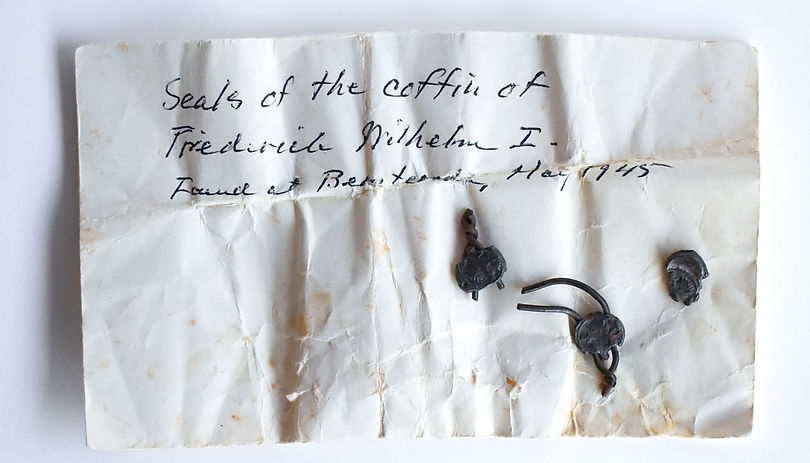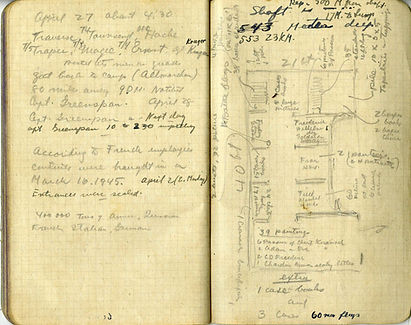Restitution of Historic Seals from the Coffin of King Frederick William I of Prussia
In early May 1945, three historic seals from the coffin of Frederick William I (1688–1740) of Prussia, the Soldier King, were recovered and preserved by Monuments Man Captain Walker K. Hancock during the evacuation of the repository within the Bernterode mine in Thuringia, Germany. These small metallic seals, originally affixed to the king’s coffin, had detached at some point during its relocation into the mine. Captain Hancock brought the seals back to the United States after his military service, where he carefully preserved them in an envelope. They were recently rediscovered among his papers by his heir, who donated them to the Monuments Men and Women Foundation to ensure their preservation and facilitate their return.

The seals discovered inside an envelope bearing a handwritten note by Hancock.
Monuments Men and Women Foundation Collection
AT A GLANCE...
Object:
Three partial metallic seals bearing the Prussian royal eagle
Circumstances of Loss:
During World War II, the remains of Frederick William I and his son, Frederick II, more famously known as Frederick the Great, were hidden in the Bernterode potash mine in March 1945 to shield them from bombing raids. The repository—which contained the two royal coffins, the coffins of Field Marshal Paul von Hindenburg and his wife, militaria, the Prussian crown jewels, and works of art—was discovered by US Army troops on April 27, 1945. After the mine’s contents were inspected by Monuments Men Captain Walker K. Hancock and Lieutenant George L. Stout, the Army ordered its evacuation by the Monuments, Fine Arts, and Archives section. The seals were likely dislodged during the delicate recovery and evacuation process and ultimately came into the possession of Captain Hancock. Recognizing their significance, he carefully preserved them..
Restitution:
On September 1, 2025, at Burg Hohenzollern in Baden-Württemburg, Germany, the Monuments Men and Women Foundation returned the coffin seals of Frederick William I to the House of Hohenzollern.
Discovery and Research
The seals were originally attached to the coffin of Frederick William I of Prussia, who was initially interred in the royal crypt of the Garrison Church of Potsdam, along with his son, Frederick the Great. As Allied bombing escalated in 1943, the Nazi regime ordered the relocation of the Prussian kings’ coffins to safeguard both their physical remains and their symbolic significance. They were brought to the headquarters of the Luftwaffe high command, the bunker known as Kurfürst, in Wildpark-Werder near Potsdam, where they were later joined by the coffins of the Hindenburgs, which had been evacuated from East Prussia, away from the advancing Soviet Red Army. In March 1945, all four coffins were relocated a final time under Hitler’s orders to the Bernterode mine in Thuringia. It was sealed on April 2, 1945, just before American forces began liberating the area.
On April 27, 1945, US Army soldiers from the 350th Ordnance Depot Company discovered the mine. Monuments Man Captain Walker Hancock arrived just two days later, quickly realizing that the nature and arrangement of the contents within were “planned to perpetuate the tradition of German military glory.” A wreath and red silk ribbon inscribed with “Adolf Hitler” lay atop Frederick William I’s coffin—perhaps a personal tribute from the Führer to the Soldier King. The site was packed with paintings, tapestries, and archival materials. In nearby corridors, 400,000 tons of ammunition and explosives were also stored. Evacuation operations began immediately under the skilled leadership of Monuments Man Lieutenant George L. Stout, with support from Captain Hancock, US Army personnel, and displaced persons at the site.
In 2021, Walker Hancock’s heir reached out to the Foundation and donated the seals. Foundation researchers reached out to the curator of the General Administration for the Former Ruling Prussian Royal House. Following years of planning and discussion with the House of Hohenzollern, the restitution was finalized.

Monuments Man Capt. Walker Hancock’s personal journal, kept during his military service, contains meticulous records of the Bernterode mine repository. On the right-hand page, he sketched the layout and documented its contents with measurements, object counts, and identifications. On the left, he noted key findings and observations made during his investigation. Gift of Deanie Hancock French, The Monuments Men and Women Foundation Collection, The National WWII Museum, New Orleans, LA.

Loading one of the coffins into a US Army truck on May 8, 1945.
National Archives (239-PA-4-127-03).
Restitution Ceremony
In a ceremony at Burg Hohenzollern on September 1, 2025, the Monuments Men and Women Foundation returned the coffin seals of Frederick William I of Prussia, the Soldier King, to the House of Hohenzollern. Foundation founder and chairman Robert M. Edsel, accompanied by senior researchers Dorothee Schneider and Casey Shelton, presented the seals to HRH Georg Friedrich, Prince of Prussia, and Dr. Anja Hoppe, manager of Burg Hohenzollern.
“Restitution of these seals to the House of Hohenzollern represents more than just the return of a cultural treasure. Ceremonies like this go to the heart of the mission of the Monuments Men and Women Foundation: to complete the work of the Monuments Men and Women by ensuring that missing works of art and cultural objects are returned to their rightful owners.”
-Anna Bottinelli, President of the Monuments Men and Women Foundation
Donate to our Restitution Fund
Our team receives leads on works of art on a daily basis and is committed to researching each one of them. Research can be very time-consuming and expensive. Financial support can contribute to adding professionals to our experienced team as well as off-set the costs involved with restitutions.
.png)



















